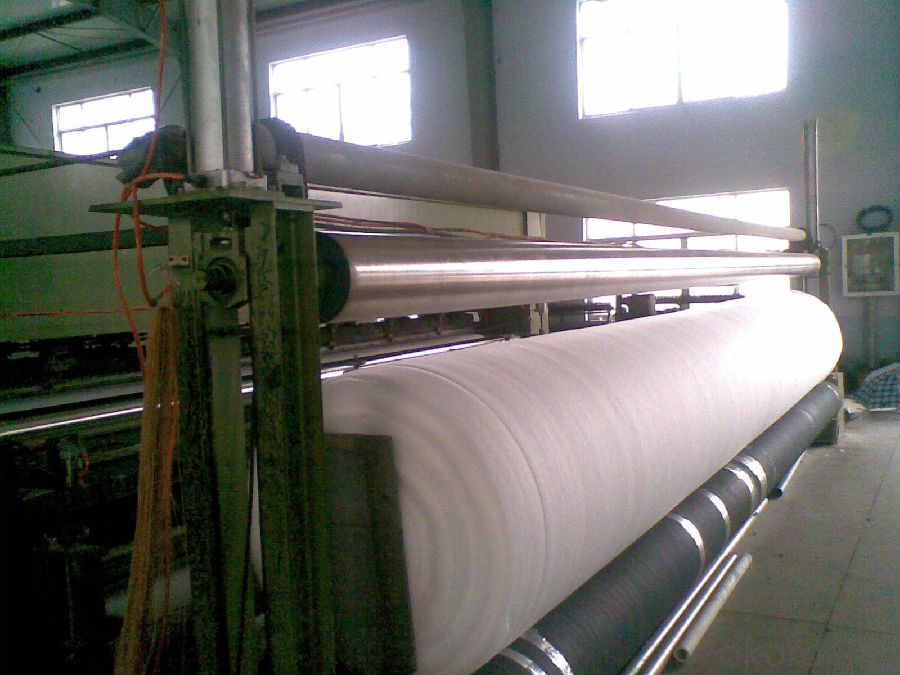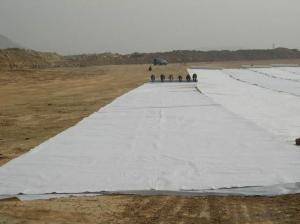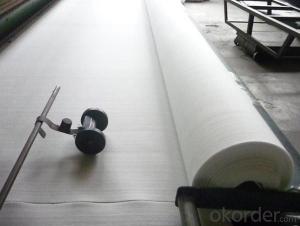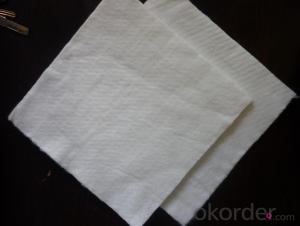Polyester Nonwoven Geotextile Fabric for Construction
- Loading Port:
- Qingdao
- Payment Terms:
- TT OR LC
- Min Order Qty:
- 50000 m²
- Supply Capability:
- 5000000 m²/month
OKorder Service Pledge
OKorder Financial Service
You Might Also Like
Product Description:
1,Specification of Polyester Nonwoven Geotextile Fabric for Construction
1)Area Weight: 100g/m2-1500g/m2
2) Width: Within 6 m (1m-6m)
3) Length: 50m-100m/roll (as per request)
4) Material: Polypropylene or polyester
2,Specialities of Polyester Nonwoven Geotextile Fabric for Construction:
1) Staple fibers needle punched nonwoven geotextile
The geotextile is made of polypropylene staple fibers on cross-laying equipment and needle punched equipment. It owns the advantages of acid and alkali resistance, erosion resistance, aging resistance, large strength, stable size, good filtrability etc.
2) Filament nonwoven geotextile
Filament geotextile has features as follows: High strength, good capacity of elongation and high biology tolerance, alkali tolerance, acidity tolerance, weather resistance good filtration and fine drainage capacity etc. Also it is of low cost, easy in construction and use effects.
3,Package of Polyester Nonwoven Geotextile Fabric for Construction:
Each roll is wrapped with plastic film.
4,Application of Polyester Nonwoven Geotextile Fabric for Construction:
1) Filtration :
The filtration layer of the dykes, river canal, seacoast, concrete slope, retaining walls. At the same time of preventing the clay granule from passing, it allows the water and the gas pass through freely.
2) Separation :
The isolation of the railway dregs and the roadbed, roadbed and the soft base, surface of the airdrome and parking lot and the groundsill, different dam materials. It isolates the soil and the gravel of two kinds different granule pathway from the groundsill or other buildings.
3) Protection :
It prevents the bank from being washed out, protects the bank and the bottom, prevents the water and soil from being washed away.



6.FAQ
We have organized several common questions for our clients,may help you sincerely:
1>How about your company?
A manufacturer & supplier focuses on the production of construction materials, including but not limited to PP staple fiber, geotextile geo-grid, geo-bag etc. Customized product is also available based on your detailed requirements.
2>How long can we receive the product after purchase?
It takes about 1 to 4 weeks to finish the production based on the specific production schedual. Then it will depend on the shipping time from loading port to the destination port.
- Q:How do geotextiles improve the performance of geosynthetic clay liners?
- Geotextiles improve the performance of geosynthetic clay liners by providing additional reinforcement and stability. They act as a separation layer, preventing the mixing of different materials, such as clay and other fill materials. Geotextiles also enhance drainage capabilities by allowing water to flow through while retaining fine particles. Ultimately, they improve the overall strength, durability, and long-term performance of geosynthetic clay liners in various applications such as landfill liners and erosion control measures.
- Q:How do geotextiles help with soil separation in subgrade improvement projects?
- Geotextiles are used in subgrade improvement projects to separate different soil layers, preventing them from mixing. They act as a barrier, allowing water to pass through while preventing the migration of fine particles. This helps to maintain the stability and strength of the subgrade, reducing the risk of settlement and soil erosion.
- Q:How do geotextiles help with soil stabilization in geocell applications?
- Geotextiles aid in soil stabilization in geocell applications by providing a barrier between the soil and the geocell structure. This helps to prevent soil erosion, promote proper drainage, and increase the overall strength and stability of the soil.
- Q:Geotextile what is the law?
- Main products are mainly engaged in the production of various glass fiber geogrid, warp knitting polyester geogrid, one-way plastic stretch geogrid, two-way plastic tensile geogrid, coal mine with two-way stretch plastic protection network, steel Plastic composite geogrid, coal mine with two-way welding plastic false top net, high-strength spiral ribs overall steel grille, a new three-dimensional geotextile mat, high-strength geotextile, geocell, engineering fiber, geotextile, Grille, bentonite waterproof blanket, two-way plastic geogrid, fiberglass geogrid, composite geomembrane, chopped blankets and other engineering materials.
- Q:Will the geotechnical cloth used for highway engineering, geogrid raw materials, routine testing items, parameters which?
- Will the geotechnical cloth used for highway engineering, geogrid raw materials, routine testing items, parameters which?
- Q:The technical parameters of woven geotextile
- Test items / specifications 0400 Remarks breaking strength (longitudinal) KN / m ≥ 17. Breaking strength (horizontal) KN / m ≥ no special requirements by the meridional 0.7 / 1 longitudinal and transverse elongation at break% ≤ 25 vertical and horizontal trapezoidal torn Strength, KN ≥ 0.180.200.270.340.410.480.600.72 vertical and horizontal CBR top breaking strength, KN ≥ 1.41.62.43.24.04.86.07.5 equivalent aperture O95 (O95) mm0.07-0.5 vertical permeability coefficient cm / sK × (10-1-10-4) K = 1.0-9.9
- Q:What are the environmental considerations of geotextiles?
- Geotextiles have several environmental considerations, including their potential to release microplastics into the environment, their impact on soil and water quality, and their potential for improper disposal. Additionally, the production and manufacturing processes of geotextiles may contribute to carbon emissions and energy consumption, further affecting the environment. Therefore, proper usage, disposal, and monitoring of geotextiles are essential to minimize their environmental impact.
- Q:Can geotextiles be used for filtration of contaminants in water?
- Yes, geotextiles can be used for filtration of contaminants in water. They are commonly used in various filtration systems, including wastewater treatment plants, to effectively remove pollutants and particles from the water. Geotextiles act as a physical barrier, allowing water to pass through while trapping and retaining contaminants, thus improving water quality.
- Q:How do geotextiles help in reducing the risk of slope failures?
- Geotextiles help in reducing the risk of slope failures by providing reinforcement and stabilization to unstable slopes. These materials are placed within the slope to increase its strength and prevent erosion. Geotextiles also help in promoting water drainage and filtration, which reduces the build-up of hydrostatic pressure within the slope. Overall, geotextiles enhance the stability of slopes and mitigate the potential for landslides or slope failures.
- Q:How do geotextiles help with reinforcement of geosynthetic clay liner slopes?
- Geotextiles provide reinforcement to geosynthetic clay liner slopes by adding tensile strength and stability to the structure. They act as a barrier against soil erosion and prevent the clay liner from sliding or slumping. Geotextiles also enhance the overall performance and longevity of the slope by distributing load and reducing stress on the liner.
1. Manufacturer Overview |
|
|---|---|
| Location | |
| Year Established | |
| Annual Output Value | |
| Main Markets | |
| Company Certifications | |
2. Manufacturer Certificates |
|
|---|---|
| a) Certification Name | |
| Range | |
| Reference | |
| Validity Period | |
3. Manufacturer Capability |
|
|---|---|
| a)Trade Capacity | |
| Nearest Port | |
| Export Percentage | |
| No.of Employees in Trade Department | |
| Language Spoken: | |
| b)Factory Information | |
| Factory Size: | |
| No. of Production Lines | |
| Contract Manufacturing | |
| Product Price Range | |
Send your message to us
Polyester Nonwoven Geotextile Fabric for Construction
- Loading Port:
- Qingdao
- Payment Terms:
- TT OR LC
- Min Order Qty:
- 50000 m²
- Supply Capability:
- 5000000 m²/month
OKorder Service Pledge
OKorder Financial Service
Similar products
New products
Hot products
Hot Searches
Related keywords






























